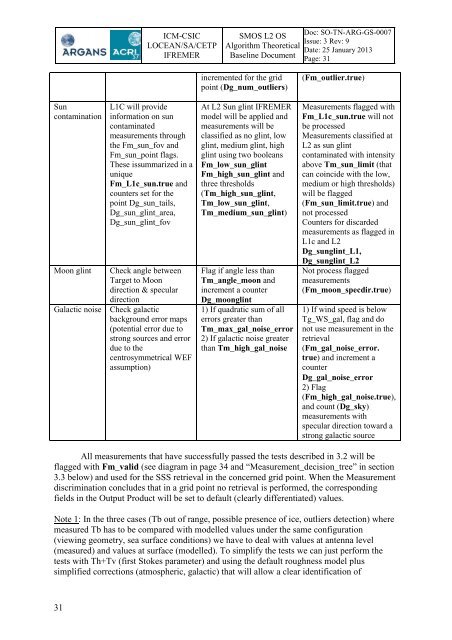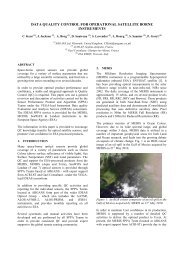SMOS L2 OS ATBD - ARGANS
SMOS L2 OS ATBD - ARGANS
SMOS L2 OS ATBD - ARGANS
Create successful ePaper yourself
Turn your PDF publications into a flip-book with our unique Google optimized e-Paper software.
Sun<br />
contamination<br />
31<br />
ICM-CSIC<br />
LOCEAN/SA/CETP<br />
IFREMER<br />
L1C will provide<br />
information on sun<br />
contaminated<br />
measurements through<br />
the Fm_sun_fov and<br />
Fm_sun_point flags.<br />
These issummarized in a<br />
unique<br />
Fm_L1c_sun.true and<br />
counters set for the<br />
point Dg_sun_tails,<br />
Dg_sun_glint_area,<br />
Dg_sun_glint_fov<br />
Moon glint Check angle between<br />
Target to Moon<br />
direction & specular<br />
direction<br />
Galactic noise Check galactic<br />
background error maps<br />
(potential error due to<br />
strong sources and error<br />
due to the<br />
centrosymmetrical WEF<br />
assumption)<br />
<strong>SM<strong>OS</strong></strong> <strong>L2</strong> <strong>OS</strong><br />
Algorithm Theoretical<br />
Baseline Document<br />
incremented for the grid<br />
point (Dg_num_outliers)<br />
At <strong>L2</strong> Sun glint IFREMER<br />
model will be applied and<br />
measurements will be<br />
classified as no glint, low<br />
glint, medium glint, high<br />
glint using two booleans<br />
Fm_low_sun_glint<br />
Fm_high_sun_glint and<br />
three thresholds<br />
(Tm_high_sun_glint,<br />
Tm_low_sun_glint,<br />
Tm_medium_sun_glint)<br />
Flag if angle less than<br />
Tm_angle_moon and<br />
increment a counter<br />
Dg_moonglint<br />
1) If quadratic sum of all<br />
errors greater than<br />
Tm_max_gal_noise_error<br />
2) If galactic noise greater<br />
than Tm_high_gal_noise<br />
Doc: SO-TN-ARG-GS-0007<br />
Issue: 3 Rev: 9<br />
Date: 25 January 2013<br />
Page: 31<br />
(Fm_outlier.true)<br />
Measurements flagged with<br />
Fm_L1c_sun.true will not<br />
be processed<br />
Measurements classified at<br />
<strong>L2</strong> as sun glint<br />
contaminated with intensity<br />
above Tm_sun_limit (that<br />
can coincide with the low,<br />
medium or high thresholds)<br />
will be flagged<br />
(Fm_sun_limit.true) and<br />
not processed<br />
Counters for discarded<br />
measurements as flagged in<br />
L1c and <strong>L2</strong><br />
Dg_sunglint_L1,<br />
Dg_sunglint_<strong>L2</strong><br />
Not process flagged<br />
measurements<br />
(Fm_moon_specdir.true)<br />
1) If wind speed is below<br />
Tg_WS_gal, flag and do<br />
not use measurement in the<br />
retrieval<br />
(Fm_gal_noise_error.<br />
true) and increment a<br />
counter<br />
Dg_gal_noise_error<br />
2) Flag<br />
(Fm_high_gal_noise.true),<br />
and count (Dg_sky)<br />
measurements with<br />
specular direction toward a<br />
strong galactic source<br />
All measurements that have successfully passed the tests described in 3.2 will be<br />
flagged with Fm_valid (see diagram in page 34 and “Measurement_decision_tree” in section<br />
3.3 below) and used for the SSS retrieval in the concerned grid point. When the Measurement<br />
discrimination concludes that in a grid point no retrieval is performed, the corresponding<br />
fields in the Output Product will be set to default (clearly differentiated) values.<br />
Note 1: In the three cases (Tb out of range, possible presence of ice, outliers detection) where<br />
measured Tb has to be compared with modelled values under the same configuration<br />
(viewing geometry, sea surface conditions) we have to deal with values at antenna level<br />
(measured) and values at surface (modelled). To simplify the tests we can just perform the<br />
tests with Th+Tv (first Stokes parameter) and using the default roughness model plus<br />
simplified corrections (atmospheric, galactic) that will allow a clear identification of



